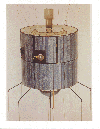 GOES-NEWS last update 7 October 2008
GOES-NEWS last update 7 October 2008
 GOES-NEWS last update 7 October 2008
GOES-NEWS last update 7 October 2008
 NOAA INFORMATION ON
THE WEB
NOAA INFORMATION ON
THE WEB
 GOES-I/M series
GOES-I/M series
The heavy-launcher used on GOES-11/-12 delivered the satellites efficiently with about 10-years of station-keeping fuel, which is normally the life-limiting factor for GOES satellites. The same heavy-launch strategy is being used for Boeing's GOES-N/O/P satellites.
Construction and launch dates for GOES have been arranged to assure two-satellite operations while minimizing storage costs by using "free" on-orbit storage. GOES-12 was activated as GOES-EAST in the spring of 2003, before GOES-11, in order to use the unique Solar X-ray Imager (SXI) on GOES-12.
| Loral Contract | ||||
|---|---|---|---|---|
| Spacecraft | Launch Readiness | Launch Date | Operations Date | Retirement Date |
| GOES-I (-8) | April 1994 | April 1994* | June 1995 | March 2003 |
| GOES-J (-9) | April 1995 | May 1995* | January 1996 | November 2005 |
| GOES-K (-10) | April 1997 | April 1997* | August 1998 | June 2006+ |
| GOES-L (-11) | May 1999 | May 2000* | June 2006 | December 2011? |
| GOES-M (-12) | October 2000 | July 2001* | March 2003 | July 2009? |
| Boeing (formerly Hughes) Contract | ||||
| Spacecraft | Launch Readiness | Launch Date | Operations Date | Retirement Date |
| GOES-N (-13) | January 2005 | May 2006* | July 2009? | July 2014? |
| GOES-O | December 2005 | March 2009 | December 2011? | December 2016? |
| GOES-P | April 2007 | September 2009 | July 2014? | April 2019? |
| GOES-Q | N/A | N/A | N/A | N/A |
| GOES-R Contractor TBD | ||||
| Spacecraft | Launch Readiness | Launch Date | Operations Date | Retirement Date |
| GOES-R | October 2012? | April 2015? | January 2017?? | October 2024?? |
| GOES-S | April 2014? | April 2016? | April 2019?? | April 2026?? |
| GOES-T? | April 2017?? | April 2018?? | October 2024?? | October 2028?? |
| GOES-U? | April 2019?? | April 2020?? | April 2026?? | April 2030?? |
GOES-K (GOES-10) was launched in April 1997, well before GOES-I/J's expected end-of-life, in order to get a spare satellite safely on-orbit. That proved to be good planning, because GOES-K (GOES-10) had to immediately replace GOES-J (GOES-9) as GOES-WEST in August 1998, after only one month of on-orbit storage.
In 2003, NOAA positioned GOES-9 over the western Pacific, to help Japan in case the aging GMS-5 satellite failed before Japan can launch a replacement. Japan paid for a control center in Fairbanks, Alaska, in order to be able to operate GOES west of the dateline.
In 2006, NOAA positioned GOES-10 at 65W, for dedicated scanning of South America and tropical storms in hurricane alley. GOES-10 is out of inclination-keeping fuel, so the satellite no longer stays over the equator. Consequently, imagery has to be reprocessed to make it look like it comes from a geostationary satellite.
Since 1990, the launch-and-deploy failure rate has been about 15% (1 in 7) for comparable civilian geosynchronous communications satellites. During the same time, the failure rate for GOES has been 0 in 7, due to the mission assurance work provided by NASA.
The advantage to an "on-orbit spare" is that it can be made operational in less than one month. For example, GOES-K was called up after just one month as an "on-orbit spare". If GOES satellites were kept in on-earth storage subject to NOAA call-up, there would be about 9 months of preparation and testing between call-up and launch, followed by 3 months of post-launch deployment and testing before the satellite could become operational.
MY STATUS REPORTS:
On-line GOES images from the active satellites are widely available on the Web. Help yourself.
 GOES-NO(PQ) Series
GOES-NO(PQ) Series
On this series, the GOES-N/O/P Imagers will not have the 12-13 micron channel (a volcanic ash-sensitive channel which was converted to a cloud-sensing 12.9-13.8 micron channel on GOES-M). GOES-O/P will have improved 4 km resolution in the 13 micron channel.
With the Loral spacecraft lasting longer than expected, NOAA decided in 2002 to not exercise the option for GOES-Q, even though they have already purchased the corresponding Imager and Sounder from ITT. The GOES-NOPQ contract is remarkable for being fixed-price, with delivery on-orbit, and with a warranty for one no-cost replacement satellite if something fails that is critical to the GOES mission.
 ATS series
ATS series

In 1999, JT Young at the University of Wisconsin digitized the ATS-3 color photos from 1967, making possible the first day-long color QuickTime movie of the Earth, taken on 18 November 1967.
 GOES-A/H series
GOES-A/H series
Geostationary Satellite Status 06/30/95
GOES-7: Launched 02/26/87
Inclination: 2.27 degrees
Avg. Altitude: 22239 miles
Longitude Pos. 134.73
Drift (deg/day) .046W
Sensor Status: DCE #1 can on occasion cause loss of earth lock
HEPAD failed since launch.
Range transponder side 2 below specs.
Operation: VISSR/VAS
SEM
SAR
West WEFAX
DCS
ORBITAL ELEMENTS FOR GOES - 7 ,SATID 8702201.,IDSAT
9
EPOCH 97Y 5M 11D 0H 0M 0S UT
SEMI-MAJOR AXIS 42169.440 KILOMETERS
ECCENTRICITY 0.0007510
INCLINATION 3.69930 DEGREES
R. A. OF ASC. NODE 67.205 DEGREES
ARGUMENT OF PERIGEE 311.204 DEGREES
MEAN ANOMALY 113.923 DEGREES
LONGITUDE 96.5000 DEGREES
WEST
ATTITUDE:
RT. ASC. 160.260 DEGREES
DECLINATION -87.540 DEGREES
SPIN: PERIOD/RATE 0.59981 SEC/ 100.0310 RPM
GOES-7 went to stand-by in January 1996, and parked at 95W in June 1996. This means the VAS instrument, and the associated Mode-AAA retransmitted instrument data format, along with WEFAX, Data Collection Service, and Search and Rescue services through GOES-7 were all turned-off.
In mid-November 1999, GOES-7 will be moved to 175W, to take over the communications-relay duties of PEACESAT. The high orbital inclination makes it possible to relay data from near the poles, particularly to support the NSF science group at the South Pole.
ORBITAL ELEMENTS FOR GOES - 6 ,SATID 8304101.,IDSAT
8
EPOCH 94Y 9M 18D 3H 56M 40S UT
SEMI-MAJOR AXIS 42174.291 KILOMETERS
ECCENTRICITY 0.0003190
INCLINATION 5.77540 DEGREES
R. A. OF ASC. NODE 59.959 DEGREES
ARGUMENT OF PERIGEE 30.276 DEGREES
MEAN ANOMALY 197.133 DEGREES
LONGITUDE 128.8000 DEGREES
WEST
ATTITUDE:
RT. ASC. 138.474 DEGREES
DECLINATION -89.791 DEGREES
SPIN: PERIOD/RATE 0.58317 SEC/ 102.8860 RPM
Geostationary Satellite Status 06/30/95 GOES-3: Launched 06/16/78 Inclination: 10.76 degrees Avg. Altitude: 22231 miles Longitude Pos. 170.14 Drift (deg/day) .120E Sensor Status: Reduntant encoder failed 09/14/79 Operation: None
Inclination: 11.79 degrees
Avg. Altitude: 22240 miles
Longitude Pos. 176.22
Drift (Deg/Day) .054W
Sensor Status: VISSR unusable 01/16/79
Magnetometer intermittent 04/24/83
Operation: PEACESAT Transponder
ORBITAL ELEMENTS FOR GOES - 2 ,SATID 7704801.,IDSAT
4
EPOCH 95Y 9M 14D 18H 31M 2S UT
SEMI-MAJOR AXIS 42171.651 KILOMETERS
ECCENTRICITY 0.0013994
INCLINATION 11.95280 DEGREES
R. A. OF ASC. NODE 40.294 DEGREES
ARGUMENT OF PERIGEE 118.896 DEGREES
MEAN ANOMALY 298.101 DEGREES
LONGITUDE 173.7790 DEGREES
WEST
ATTITUDE:
RT. ASC. 131.829 DEGREES
DECLINATION -75.456 DEGREES
SPIN: PERIOD/RATE 0.60133 SEC/ 99.7790 RPM
 NASA Official: Dennis.Chesters@nasa.gov
NASA Official: Dennis.Chesters@nasa.gov